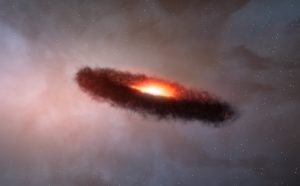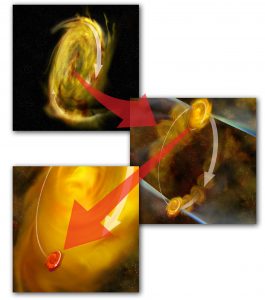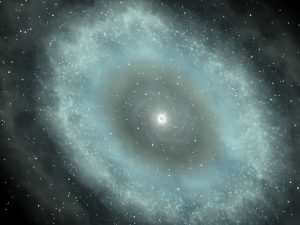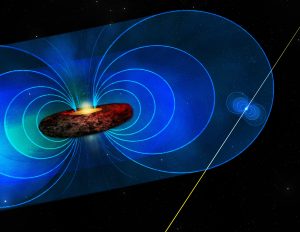This artist’s impression shows the disc of gas and cosmic dust around a brown dwarf. Rocky planets are thought to form through the random collision and sticking together of what are initially microscopic particles in the disc of material around a star. These tiny grains, known as cosmic dust, are similar to very fine soot or sand. Astronomers using the Atacama Large Millimeter/submillimeter Array (ALMA) have for the first time found that the outer region of a dusty disc encircling a brown dwarf — a star-like object, but one too small to shine brightly like a star — also contains millimetre-sized solid grains like those found in denser discs around newborn stars. The surprising finding challenges theories of how rocky, Earth-scale planets form, and suggests that rocky planets may be even more common in the Universe than expected.


Disks Inside Disks
An artist’s interpretation of a radio object known as L1551 IRS5, which is two young star systems, still surrounded by a disk of gas and dust, in orbit around each other.

A Disk of Starforming Gas
Artist’s conception of the disk of star-forming gas around the center of the galaxy hosting the quasar PSS J2322+1944. The disk is about 13,000 light-years in diameter. The luminous quasar, powered by the infall of matter into a supermassive black hole, is at the center.

Model of a Black Hole
Deep inside the monster galaxy M87 is a supermassive black hole. In this artist’s model, the black hole is the tiny dot in the center of a whirling disk of heated gas. Strong magnetic fields surround the disk and the north and south poles of the field act like railroad track to spiral charged particles outward.

Galactic Bridge
An artist’s impression of the enormous bridge of hydrogen that spans the space between our neighboring galaxies Andromeda and Triangulum. The bridge was discovered using the Robert C. Byrd Green Bank Telescope (GBT) in West Virginia.

Measuring a Magnetic Field
In this artist’s illustration, the black hole at the center of our Milky Way Galaxy has an intense magnetic field around it. We know it’s intense, because a pulsar was discovered inside the field. Like a buoy bouncing on the waves, the pulsar’s pulse twisted in this field. The amount of twist helped gauge the strength of the field and hence the power of the black hole’s environment.





